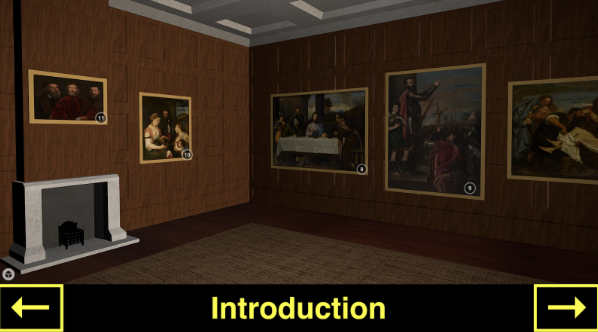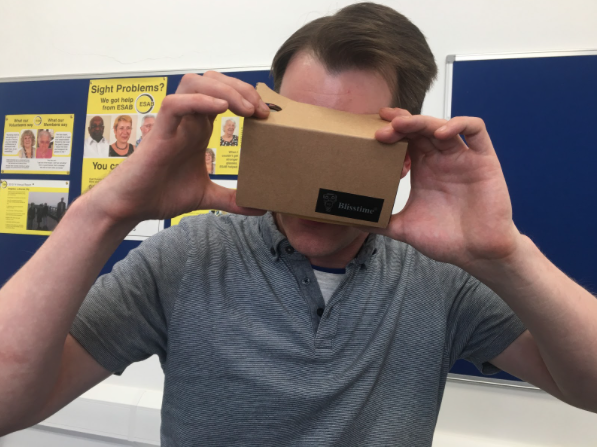Chapter 12. “Virtual Accessibility”: Interpreting a Virtual Reality Art History Experience for Blind and Partially Sighted Users
- Amy Hetherington
- Peter Pavement
Virtual Reality (VR) has come back into fashion in the museum world – the latest wave of technology has produced a variety of creative responses from the cultural heritage sector and its suppliers. Institutions have employed the technology as a new interpretation medium, aiming to deliver explanations and narratives in an immersive environment. Others have used VR to go “beyond the walls” of their buildings, with a plethora of remote museum tours or digitally reproduced historic buildings made available for virtual visits.
Our company, the museum-specialist digital media development agency Surface Impression, was commissioned by the Royal Collection Trust in London, UK to create a virtual reconstruction of the private art galleries of the Stuart-era King Charles I (1600–1649) alongside an online catalog of the fine art collection that Charles had amassed. The aim of the virtual reconstruction was to use 3D visualization to attempt to recreate the hanging of some of the most spectacular pieces from his collection, that were housed in a suite of rooms at Whitehall Palace in London. The virtual environment was to be based on historical evidence and documents, that will be detailed below.
Although excited by the subject matter and the use of the technology, we were mindful of the accessibility barriers posed by VR. Surface Impression has been active proponents of digital accessibility for culture and heritage, and we have accumulated a reputation for expertise in the field—especially through our work with disability charities and disability arts practitioners. Virtual Reality poses an interesting challenge for accessibility; on the one hand it is a way to bring experiences to people who might not be able to physically visit a location, but on the other hand, it is a medium that presents barriers to those with mobility impairments and especially to those who are blind or visually impaired.
Project Background
King Charles was an enthusiastic collector of Renaissance art and purchased a large number of works. The art that Charles owned was distributed among his many royal palaces, but he took the (at the time) unusual step of creating a series of dedicated spaces at the Palace of Whitehall in London—“privy” (private) galleries arranged purely for the enjoyment of art. However, these artworks were later auctioned off after Charles’ death, and the Palace burnt down in 1698.
The two essential historical documents that provide evidence about the collection, are both inventories of works. The Van der Doort Inventory was a catalog produced by Abraham Van der Doort, a Dutchman commissioned to look after the King’s collection. The second, known as the Sale Inventory, was essentially a fire sale catalog, drawn up after the King’s execution in order to facilitate the liquidation of assets. The content of these inventories provide details on the titles, artists, measurements, locations, and contents of the art and have been a crucial historical source for art historians for many decades. Royal Collection Trust curator, Niko Munz, had been working through the inventories for years, compiling them into spreadsheets that could be used for data sources and locating art pieces that survive to this day. Combining this data with archaeological studies of the Palace of Whitehall and evidence from contemporary Tudor and Stuart period great houses, we were able to create a virtual reconstruction of three key Privy rooms.
The inventories informed the order and sometimes the position of paintings relative to doors and windows, and archaeology provided dimensions of the rooms. However, many decisions came down to the interpretation of the project’s creative practitioners—the hanging height of a painting or the position of a chimney breast relative to the roof’s ridge were subjective decisions. The works, however, are mostly still in existence and could be relied upon for accurate dimensions, content and sometimes even framing.
Research & Development
We decided to undertake a small piece of research and development work alongside this VR project for the Royal Collection Trust and investigate how this project could be made more accessible to people with visual impairments.
To assist with the R&D aspect of the project, we engaged VocalEyes, a London-based charity that provides audio description for people who are blind or partially-sighted. Their main work is providing live audio description at theatrical performances throughout the UK, but in recent years they have branched out into museum tours and providing pre-recorded material for handheld visitor guides and apps.
Taking one of the virtual rooms, and working with the Royal Collection Trust curator, a VocalEyes audio describer interpreted both the spatial arrangement of the Privy gallery and the paintings. In one minute recordings, the description encompasses both visual aspects and interpretation of the paintings in a rich, engaging style. For example, Titian’s “St Margaret” is described as follows:
Saint Margaret, in a knee-length mint-green dress with a scooped neck over a fine white chemise, runs towards us through a rocky landscape, both arms swinging out to the left. Her fair-skinned left leg stretches forwards. Her unseen right leg is presumably directly behind as she steps over a defeated lizard-like dragon that curls across the bottom of the picture […]
 Figure 1
Figure 1
As a delivery mechanism for the 3D environment, we chose SketchFab—an online platform created for the sharing of 3D models. SketchFab has an accomplished range of tools and, most importantly, works on most devices. As part of our experiment, we wanted to use a platform that smaller museums could conceivably utilize for 3D projects. However, applying the audio to the 3D environment of the Privy Gallery was challenging—SketchFab supports audio, but triggering playback for this project was impossible. To deal with this, we made use of SketchFab’s API (Application Programming Interface) to code an alternative method that would trigger audio for each painting, and we also added some high contrast, large buttons to make navigation through the room easier.
 Figure 2
Figure 2
To iterate development of our product, we tested the reconstruction with partially sighted participants from a local charity for people who are blind or visually impaired. Our testers were very engaged–trying out the Google Cardboard headset enthusiastically and quickly feeding back positives and areas that needed improvement. Through their help, we were able to rapidly improve navigation, and also that impaired sight does not mean impaired engagement – our testers were not art aficionados by any means, but they all were very interested in the experience and wanted to go further than what was on offer.
 Figure 3
Figure 3
Based on this project’s experience, we are now able to refine both the content and the technical implementation of audio description in VR environments, and we’re keen to undertake work to improve other aspects of accessibility in the medium (for example, for those who have mobility impairments). Above all, the experience has taught us that blind and partially sighted users of Virtual Reality are, given the opportunity, as enthusiastic an audience as any other.
Each time a new media technology arises, or, as with VR, is revived, it is often enthusiastically adopted by people working in the cultural heritage sector. However, unlike more mature applications of technology, accessibility practice may not yet be established for the new medium. This poses both a challenge and an opportunity for museums and those who work with them. The accessibility challenges of a new media technology can seem insurmountable, but by working creatively with those that have built up expertise in other fields (in this case VocalEyes) and, above all, with the communities who will benefit from greater access, then opportunities for new techniques, methods, and means of museum communication will emerge.